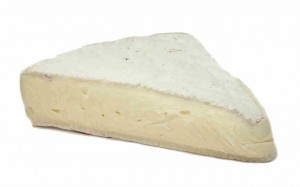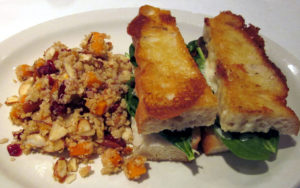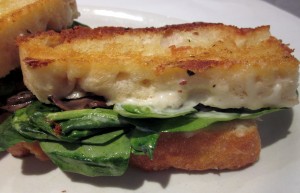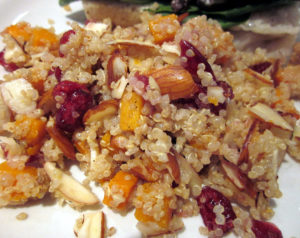- March 4th, 2011
- 2 Comments
 Who doesn’t love the delicate and creamy taste of brie? Out of more than four hundred varieties of cheese that France produces, brie is among its most popular. After recently enjoying it in our grilled brie sandwich, I decided to take a closer look at brie and discover why the French proudly proclaim it as “the king of cheeses.”
Who doesn’t love the delicate and creamy taste of brie? Out of more than four hundred varieties of cheese that France produces, brie is among its most popular. After recently enjoying it in our grilled brie sandwich, I decided to take a closer look at brie and discover why the French proudly proclaim it as “the king of cheeses.”
It turns out that brie has been seducing sophisticated palates, including kings’, since the eighth century. The earliest documentation of brie is from the year 774, when it was eaten by the Holy Roman Emperor Charlemagne. He had visited the French city of Brie, located about seventy-five miles northeast of Paris, and was treated to the delicious cheese bearing the city’s namesake. Flash forward about a thousand years later, to 1793. Legend has it that King Louis XVI’s final wish was to have a taste of brie.
Soon after the execution of Louis XVI, Napoleon Bonaparte steadily rose to power and spent more than a decade fighting wars with several European countries. When these countries eventually gathered in Vienna to settle their grievances, brie was there to lift their spirits. A Frenchman lightheartedly suggested that the group hold a friendly competition to determine which country had the world’s best cheese. The English argued for their Stilton, the Swiss for their emmenthal, the Dutch for their Edam, and the French for their brie. Historian Jean Orieux writes, “The Brie rendered its cream to the knife. It was a feast, and no one further argued the point.” It was then that brie was denoted as “the king of cheeses” and started gaining popularity outside of France.
 How is this monarch made? First, rennet is added to raw cows’ milk and is heated to no more than 98.6 degrees to activate the rennet while ensuring that the milk remains unpasteurized. Then, the heated mixture is poured into shallow, eight-inch round containers and left alone for about 18 hours. The rennet works its coagulation magic separating the mixture into solid (curds) and liquid (whey) parts. The solids are removed from the containers, salted, injected with special cheese mold, and aged in a cellar for a handful of weeks. During this time the brie develops its characteristic, pale yellow, creamy texture and its white surface mold. Here in the United States though, pasteurization laws require raw milk cheeses to age at least 60 days. Since brie isn’t typically aged that long, the brie that we enjoy is made from pasteurized milk instead. Once aged, brie takes on a delicious, light flavor with just a hint of hazelnut and fruit to it.
How is this monarch made? First, rennet is added to raw cows’ milk and is heated to no more than 98.6 degrees to activate the rennet while ensuring that the milk remains unpasteurized. Then, the heated mixture is poured into shallow, eight-inch round containers and left alone for about 18 hours. The rennet works its coagulation magic separating the mixture into solid (curds) and liquid (whey) parts. The solids are removed from the containers, salted, injected with special cheese mold, and aged in a cellar for a handful of weeks. During this time the brie develops its characteristic, pale yellow, creamy texture and its white surface mold. Here in the United States though, pasteurization laws require raw milk cheeses to age at least 60 days. Since brie isn’t typically aged that long, the brie that we enjoy is made from pasteurized milk instead. Once aged, brie takes on a delicious, light flavor with just a hint of hazelnut and fruit to it.
Experience brie’s majesty in our grilled brie sandwich, created by Lisa – the owner – which has been on the menu since we first opened. We start with slices of house-made focaccia, baked right upstairs. Then we build the sandwich starting with generous portions of brie, then mushrooms, sautéed with rosemary, salt, and pepper, topped off with a handful of fresh spinach. “I like how the earthy flavors of mushroom and rosemary complement the slight sourness of the brie,” says executive chef Derrick. The sandwich is then grilled to perfection, where the focaccia becomes lightly toasted and the brie melts into mouthwatering, cheesy goo. The grilled brie is a simple and comforting food, a grown-up grilled cheese, a twist on a childhood classic.
we first opened. We start with slices of house-made focaccia, baked right upstairs. Then we build the sandwich starting with generous portions of brie, then mushrooms, sautéed with rosemary, salt, and pepper, topped off with a handful of fresh spinach. “I like how the earthy flavors of mushroom and rosemary complement the slight sourness of the brie,” says executive chef Derrick. The sandwich is then grilled to perfection, where the focaccia becomes lightly toasted and the brie melts into mouthwatering, cheesy goo. The grilled brie is a simple and comforting food, a grown-up grilled cheese, a twist on a childhood classic.

The grilled brie, like all of our sandwiches, comes with your choice of side. Derrick recommends the butternut squash quinoa salad in particular. “It has a great mix of textures to balance the grilled brie: chewy quinoa, crunchy almonds, and soft butternut squash. Plus it has just a touch of sweetness from the dried cranberries.” Truly, a lunch fit for kings!
[update: Red Hen no longer provides our focaccia, we bake our own]

I LOVE this blog! Learning the history behind such a delicious cheese certainly deepens my appreciation! Very well written… it’s making me hungry… (salivating…)
Thanks Eliz!